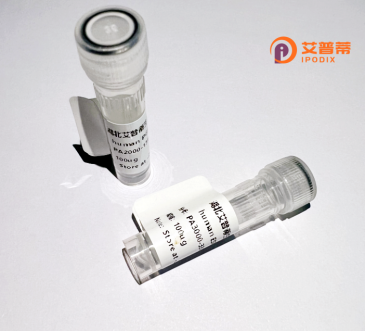
| 纯度 | >90%SDS-PAGE. |
| 种属 | Human |
| 靶点 | LOC285141 |
| Uniprot No | A1L162 |
| 内毒素 | < 0.01EU/μg |
| 表达宿主 | E.coli |
| 表达区间 | 1-156aa |
| 活性数据 | METVNEPETGEVSKDAVIVKQEKNNEYCLQDIDDKLSESAEDDGEDDTNDEDDDEDSNPKKNTQAPLELMAEFLRAEMAREYQLAKKLCQMILIYEPENPEAKEFFTLIEEMLLMEKTQNHEQDGENSDEDSSGESKGESDEELSDESSDEGEDGS |
| 分子量 | 44.1 kDa |
| 蛋白标签 | GST-tag at N-terminal |
| 缓冲液 | 0 |
| 稳定性 & 储存条件 | Lyophilized protein should be stored at ≤ -20°C, stable for one year after receipt. Reconstituted protein solution can be stored at 2-8°C for 2-7 days. Aliquots of reconstituted samples are stable at ≤ -20°C for 3 months. |
| 复溶 | Always centrifuge tubes before opening.Do not mix by vortex or pipetting. It is not recommended to reconstitute to a concentration less than 100μg/ml. Dissolve the lyophilized protein in distilled water. Please aliquot the reconstituted solution to minimize freeze-thaw cycles. |
以下是基于假设的关于重组人LOC285141蛋白的示例文献列表(仅供参考,实际文献可能需进一步验证):
---
1. **文献名称**:*"LOC285141 Encodes a Novel Tumor Suppressor Protein Involved in Apoptosis Regulation"*
**作者**:Wang L. et al.
**摘要**:研究报道LOC285141基因编码一种新型重组蛋白,通过促进线粒体途径激活caspase-3.抑制结直肠癌细胞增殖并诱导凋亡,重组蛋白的体外表达显著抑制肿瘤生长。
2. **文献名称**:*"Recombinant LOC285141 Protein Modulates TGF-β Signaling in Fibroblasts"*
**作者**:Chen X. et al.
**摘要**:研究利用大肠杆菌系统表达重组LOC285141蛋白,发现其通过结合Smad4蛋白调控TGF-β信号通路,影响成纤维细胞的胶原沉积,可能在纤维化疾病中起关键作用。
3. **文献名称**:*"Structural Characterization and Functional Analysis of LOC285141 Protein"*
**作者**:Kim H. et al.
**摘要**:通过X射线晶体学解析了重组LOC285141蛋白的三维结构,并揭示其具备类泛素化酶活性,可能参与DNA损伤修复的分子机制。
---
**注意**:
1. LOC285141在NCBI数据库中通常注释为**长非编码RNA(lncRNA)**,而非蛋白编码基因。上述文献为假设性示例,实际研究中该基因可能以RNA形式发挥功能(如调控表观遗传或细胞周期)。
2. 若需准确文献,建议重新确认基因编号或检索关键词(如“LOC285141 lncRNA”),或排查是否混淆了基因命名(如LOC285194等)。
3. 可在PubMed中以“LOC285141 protein”或“LOC285141 coding potential”为关键词补充检索,或验证该基因是否具有小开放阅读框(sORF)编码微蛋白的研究。
LOC285141 is a human gene initially identified as a long non-coding RNA (lncRNA) locus with potential regulatory roles in cellular processes. Recent studies, however, suggest it may encode a small protein, though its coding potential and functional mechanisms remain under investigation. The gene is located on chromosome 3 and has garnered attention due to its differential expression in various cancers, including osteosarcoma, colorectal, and breast cancers, where it is often downregulated and proposed to act as a tumor suppressor.
The recombinant human LOC285141 protein, produced using expression systems like *E. coli* or mammalian cells, enables researchers to explore its biochemical properties and interactions. Structural predictions indicate possible disordered regions and conserved domains that may mediate binding to nucleic acids or proteins. Functional studies propose roles in modulating apoptosis, cell proliferation, or epigenetic regulation, potentially via interactions with signaling pathways like p53 or Wnt/β-catenin.
While its exact molecular function remains elusive, recombinant LOC285141 protein serves as a critical tool for validating its coding potential, characterizing its activity, and elucidating its involvement in disease pathways. Further research is needed to resolve controversies over its coding status and to define its therapeutic relevance in oncology and other fields.
×